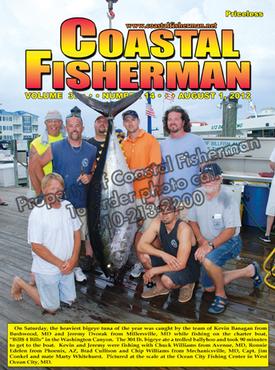


Article by
 By Jordan Zimmerman
By Jordan Zimmerman
Delaware Division of Fish and Wildlife
Every spring in the inshore waters of the mid-Atlantic, black drum arrive in great numbers to plant the seeds of the next generation. For anglers, these spawning aggregations present the unique opportunity to catch very large fish (50 pounds and over) in close proximity to the Delaware Bay shoreline. Many of these trophy class catches have been displayed in this publication over the years, often next to smiling faces. Typically, May and June are your best bet for these benthic bulldogs, as over ninety percent of black drum entries to the Delaware Sportfishing Tournament are submitted in these months.
Upon the completion of spawning, black drum often disperse throughout the Delaware Bay and coastal waterways. Targeting large fish can be much more difficult in summer and fall months, although, catches are not rare by any means. In fact, the International Game Fish Association’s world record black drum (113 pounds) was caught at Cape Henlopen in the month of September.
Unseasonably warm water temperatures this past year pushed drum into the Delaware Bay in April with some fish showing as early as March. Although fishing styles can differ along the Atlantic Coast, surf clam is the bait of choice for most Delaware anglers. Black drum will also eat other bottom dwelling creatures such as crabs, conchs, mussels, razor clams and oysters.
Tagging research suggests that black drum from New Jersey to Florida are one population with some tagged fish traveling over 400 miles at the time of recapture. Females can produce millions of eggs in one spawning season. These fish can be very old with some reaching 60 years of age or more. Baby black drum grow quickly in the tidal creeks of the Delaware Bay, reaching ten inches or greater by December when they emigrate out of the Bay, presumably to warmer climates. Oddly, fisheries biologists have not observed these fish returning to the Delaware Bay until the age of four (roughly 25 inches), about the time they become sexually mature and join the spawning schools.
Black drum have been targeted by recreational fishermen for decades, as documented catches of these fish were submitted to the original Delaware Sportfishing Tournament as early as 1939. In recent years there has been a large increase in the number of boats on traditional black drum fishing areas. These sizeable flotillas were enough for some concerned anglers to approach the Delaware Division of Fish and Wildlife seeking management and conservation of these long-lived fish.
Prior to 2010, Delaware had no black drum regulations. Absent a regional management plan, the State entered into a joint plan with New Jersey. This action essentially entailed adopting New Jersey’s drum regulations – 3 fish at 16 inches as well as a commercial quota. Due to limits on Delaware’s statutory authority, the plan only regulates Delaware fishermen in the Delaware Bay and does not apply to the inland bays in Sussex County.
In Delaware, increased fishing effort on drum has been attributed to the low abundance of other popular spring-time fishing targets like weakfish, and stricter regulations on summer flounder and tautog. Most Atlantic coast states have noted increased harvest, prompting the Atlantic States Fisheries Commission (ASMFC) to consider development of an interstate fishery management plan (FMP). Although the black drum population is not believed to be depleted, a regional FMP would give managers better tools to monitor, detect, and address fishery changes by requiring states that harvest black drum to report landings and conduct biological research.
The mid-Atlantic fishery is characterized as catching larger fish while a much higher proportion of small fish are harvested in southern states. Undoubtedly, fishing practices (harvest) in one part of the black drum’s range will influence abundance of these fish in another part. Is exploitation of large fish in the north adversely affecting the southern black drum fishery? Will increased harvest of small fish in the south eventually result in fewer large fish in the north? These questions cannot be answered without good biological and landings data. Currently, the ASMFC is moving forward with management of this species. The first step in this process is soliciting angler input through a Public Information Document. Comments can be made through the ASMFC website (www.asmfc.org) or by emailing the plan coordinator, Danielle Chesky, at [email protected]. Written comments can be mailed to: Danielle Chesky, Atlantic States Marine Fisheries Commission, 1050 North Highland St, Suite 200A-N, Arlington, VA 22201. It is your opportunity to contribute to how the black drum fishery will look in the future.
In the meantime, conservation ethics should be practiced, particularly when targeting older, larger fish as they generally contribute more to the future population. Limiting a fish’s time out of water and reducing the amount of time on the hook will go a long way towards ensuring that these fish survive for future generations of anglers. Take only what you can eat and use a camera to document the rest of your angling success.